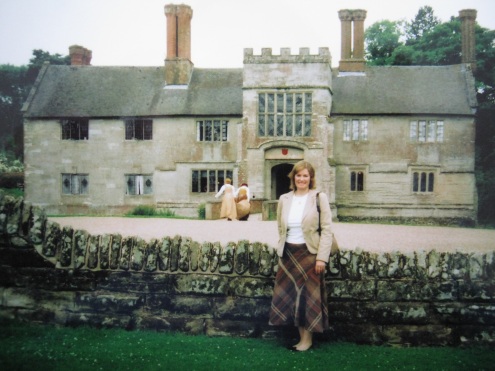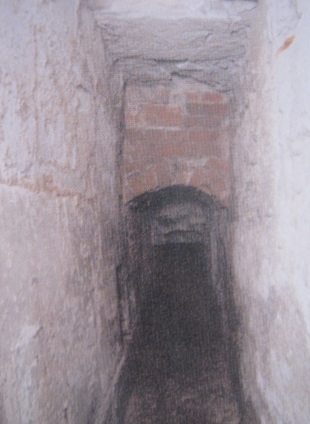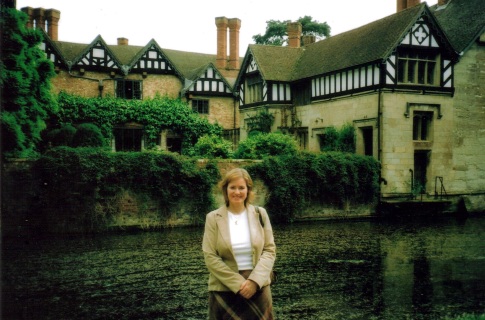
Angeline maintains a camouflaged look-out for pursuivants outside of the historical Baddesley Clinton manor house!
Remembering the Catholic Martyrs
We reflected yesterday on the need to remember the faithful witness of the Catholic martyrs who died for the Holy Sacrifice of the Mass and the One True Faith, which was established by Christ for the salvation and sanctification of souls until the end of time.
As an aid to this kind of remembrance, it seems a good time to re-post an updated version of an article on the English martyrs, which first appeared here in the summer of 2015.
Baddesley Clinton Manor House
The moated manor house of Baddesley Clinton, in the pleasant area 8 miles to the north of Warwick, is steeped in Catholic history.
The house is thought to originally date to the 13th-Century. During the 1400's, one of the owners is said to have murdered the local Catholic priest in the house. By God's grace, he repented of this sacrilegious crime and did penance by extensively restoring the local parish church of St. Michael. In that era of the Late Middle Ages, Baddesley Clinton was a moated manor, which was fortified with gunports and a draw-bridge over the moat. To this day, the moat remains to the rear of the property.
Through marriage, the house passed into the Ferrers family in 1517. In the 1590's, during the era when English Protestantism gained its hegemony over the populace, Henry Ferrers leased the property out to two strongly Catholic recusants: Anne Vaux and her widowed sister, Eleanor Brooksby.
In this period, the state had become extremely hostile to the Catholic Church and to those who continued to practice the ''old'' True Faith. The machinery of the Elizabethan persecution had driven the Catholic Church underground; outlawing the Sacred Priesthood and the Holy Sacrifice of the Mass, whilst inflicting heavy penalties on those who refused to attend the Protestant supper services.
Catholic priests who were discovered in the realm, together with those who directly sheltered them, could face torture and execution. By the end of Queen Elizabeth I's reign, some 123 Catholic priests and over 60 lay people had been executed. Countless more had endured imprisonment, heavy fines, mockery and social exclusion for keeping the Faith.
Clearly, Anne Vaux and Eleanor Brooksby were running huge risks when they began to shelter priests and allow the Baddesley Clinton manor house to be used as a venue for secret offerings of the Holy Sacrifice of the Mass.
We must remember that those risks were heightened by the fact that the Elizabethan government actively pursued priests and their accomplices by the use of a network of spys and infamous priest-hunters like the diabolically cruel torturer, Mr. Richard Topcliffe.
Jesuit Missions
These two good sisters were not the only ones running high risks at Baddesley Clinton.
Scattered at secret locations throughout the country were a number of Jesuit mission priests, under the prudent leadership of Fr. John Gerard, SJ. The dangers they faced made it necessary for them to endure long periods of isolation from their Jesuit brethren.
Once every two years, the Jesuits would come together for a clandestine conference. These biannual meetings had both spiritual and practical purposes. They provided mission priests with a forum to discuss strategy, make future plans and share important information and news. More deeply, they enabled them to make their confessions, receive ongoing formation in the sophisticated Jesuit spirituality and simply enjoy some fraternity with brother priests.
The Baddesley Clinton Conference
During October, 1591, a number of Jesuit priests and seminarians quietly converged on Baddesley Clinton for one of these biannual conferences. The time had been carefully chosen to coincide with a political election, in order to provide greater security; it was hoped that the leaders of the priest-hunters, known as pursuivants, would hopefully be engaged with other state matters for a couple of weeks.
Among those travelling to the secret meeting was the talented Jesuit lay-brother, Nicholas Owen. Known as ''Little John'', Owen had used his remarkable gifts for lateral thinking and carpentry to construct elaborate ''priest-holes'' to hide Catholic priests in the houses of the various recusant Catholic families dotted around the English countryside. Should such houses suffer the misfortune of a raid by pursuivants, the priests could be swiftly secreted away in these hiding places until the search was called off.

At Baddesley Clinton, St. Nicholas Owen had devised three good hiding places: one small room accessed through a secret wooden panel in the moat room; another in a hidden ceiling space; and a third in a narrow sewage channel. This last hiding place ran under the entire length of the southwest wing of the house. It was accessed via a rope hanging in a garderobe shaft, which was itself hidden within the thickness of a wall.

The dark sewage channel was obviously not an ideal place in which to spend any length of time; in addition to its primary purpose, it lacked access to any fresh air and was even lapped by water from the moat up to ankle-depth. Although this space was long enough to conceal up to a dozen men, they would have to crouch beneath the ceiling's 4ft maximum height.
The Raid on the House
At the conclusion of the conference, on the 14th October, 1591, some of the Jesuits saddled their horses and left after dinner. Source documents reveal that, early on the morning of the 15th October, before the remaining priests could leave, a team of pursuivant priest-hunters suddenly descended for a raid on the house.
Fr. John Gerard wrote of this frightening raid: ''I was making my meditation. Fr. Southwell was beginning Mass and the rest were at prayer, when suddenly I heard a great uproar outside the main door. Then I heard a voice shouting and swearing at a servant who was refusing them entrance.''
Fr. Southwell quickly slipped out of his Mass vestments, stripped the home altar bare and joined the others in hiding their belongings. They each turned their still-warm mattresses over, so that it would not be apparent that their beds had been slept in. Whilst the anxious Eleanor Brooksby was hidden at the top of the house, Anne Vaux bought some extra time for everyone by standing on her rights as an aristocratic lady at the front door. She demanded to be treated by the pursuivants with socially correct deference to her hierarchical social position, before allowing them entry to her home.
By the time the priest-hunters had gained entry and begun to ransack the house in their destructive haste, five Jesuit priests, two seminarians and up to three servants were hiding in the unpleasant sewage channel beneath the house.
As their hearts raced at the sound of beds being overturned, furniture being manhandled and wooden panels being beaten above their heads, these holy men must have wondered at the grim dangers the entire Jesuit mission in England then faced.
The Gravity and Context of this Particular Raid

Fr. Henry Garnet SJ: When Fr. Garnet was eventually executed on the Feast of the Cross in 1606, a bloodstained husk of straw was found, which was said to bear a likeness to the martyred priest. This relic from the scene of execution was taken to the Continent by the Society of Jesus, but lost during the French Revolution.Â
Some of the greatest names in Jesuit history had gathered at Baddesley Clinton for that particular conference of 1591. Henry Garnet, John Gerard, Robert Southwell, Edward Oldcorn, Thomas Lister, Richard Holtby and Nicholas Owen; these had all been present.
If the raiders had discovered the Jesuits that morning, almost the entire network, which had taken years to establish and develop, would have been destroyed in just one hour. Although captured priests rarely gave away any secrets, there was always the additional danger that bitter tortures might lead to still further arrests.
By God's grace, the pursuivants never did find any of the assembled Jesuits on that day. Instead, Anne Vaux served them breakfast and somebody paid them a bribe of 12 pieces of gold to call off the search after a period of time. Only after four hours had elapsed did the hidden men emerge from their lowly hiding place.
Fr. John Gerard later spoke of their experience in Biblical terms, as being like those of Daniel in the den with the lions. Indeed, not a few Catholics during that dangerous period interpreted their times through an Apocalyptic lens. They thought that the suppression of the Holy Sacrifice of the Mass meant that they were then living through the times prophesied in the book of Daniel. Of course, we now know that they were not; but those times do need to be seen as a forerunner of what must come to pass on an even larger scale before the final return of Our Lord Jesus Christ.
The raid at Baddesley Clinton marked a watershed in the history of the Jesuit mission. During the actual days of that hidden conference, Queen Elizabeth signed into law a new proclamation that further divided those who wished to be loyal to Christ in the Catholic Church, from those seeking loyalty to the queen.
Although it was the sincere faith of the martyrs that, like their ancestors before them, they could be loyal subjects of both, the signing of this newly unjust law precluded such a peace. The updated law meant that the pursuit of Catholic priests and their co-operating flocks would be intensified. From then on, the updated law and the terrors of the Baddesley Clinton raid meant that it was simply too dangerous for so many priests to meet together in one place in Elizabethan England.
Legacy
Fr. Robert Southwell was eventually caught and tortured by the evil Mr. Richard Topcliffe. He was martyred in 1595. In 1606, following a brutal clampdown in the wake of the Gunpowder Plot, Fr. Edward Oldcorne, Fr. Henry Garnet and that great craftsman of the priest-holes, Nicholas Owen, were all martyred.
The gruesome practice of hanging, drawing and quartering, whilst the victim was still conscious, should make every person of good will examine the real origins of English Protestantism and its early implementation; and thus also gain some knowledge of the foundations of today's post-modern culture as well as the strictures of a heavily surveilled society.
In addition to the actual theological, philosophical, cultural and long-term historical issues, study of these English Protestant origins would surely lead many people of good will to conclude with Bl. Cardinal John Henry Newman, that to be deep in history is to cease to be Protestant.
Certainly, every English man and woman should be given the opportunity to discover the Catholic Faith, which is the true birthright which has been denied to them by the Protestant Revolt and the subsequent decline into atheistic post-modernity.
Nothing other than the One, Holy, Catholic and Apostolic Church established by Christ can absolutely assure one's eternal salvation and sanctification. It was because the ''old'' religion, endowed with Christ's power and authority to teach, save and make holy, had been abolished through such injustice, violence and falsehood, that Fr. Robert Southwell thought that, to be truly English, was to be Catholic. We believe that the Catholic Faith is the long-forgotten and long-denied birthright of every Briton down to our own times.
Baddesley Clinton Today
The ancient manor of Baddesley Clinton is now preserved and run by the National Trust. It is a great venue for an educational, spiritual and fun day out for all people, but we would especially say that this is so for families.
Visitors today can view the priest-hole in the kitchen area and reflect on the fact that St. Nicholas Owen's work was so clever that one of the priest-holes was only discovered in 1935! As well as being of particular interest to Catholics looking for inspiration, and to folks who enjoy architecture or history, these are the kinds of things kids everywhere just love to view!
The house has a splendid chapel which bears the Latin inscription, Transit Gloria Mundi - Fides Catholica Manet. In English, this reads as, Wordly Glory is Transitory, but the Catholic Faith Endures. As you'll remember, that is the title for today's article. It is one well worth writing down in a diary, or somewhere prominent at home, and reflecting on often.
Then there are the pleasant grounds where picnics and walks can be enjoyed. Families will likely appreciate the nice woodland play area. At certain times of the year, good bargains can also be found at the book fairs. I managed to get a rock-bottom priced copy of (the normally expensive), Cardinal Mindszenty's Memoirs, during a visit one August. There is also a nice restaurant on site, providing a varied menu which includes seasonal vegetables grown in Baddesley Clinton's own garden. At certain times of the year, the staff get dressed up in period costumes to add to the Elizabethan atmosphere of the place.
For all of these reasons, and as a means to deepening one's awareness of the great Catholic history of England, Baddesley Clinton is a fondly remembered venue for days out for us here at Torch of The Faith.
It is a place of educational value, inspiration, refreshment and, above all, of pilgrimage and prayer for those who love both the Holy Sacrifice of the Mass and wish to remember those who gave their lives to keep the light of the Faith burning here in these British Isles, during such a dark period of history.
The example and prayers of these good priests and lay people will surely help us in the coming storms. They are good Heavenly friends to have, wherever you are reading this from. May their faithful witness inspire and encourage all who read this in these difficult times; which are once again so anti-Catholic and often even lonely for those who seek to follow Christ in the One True Church.
Keep the Faith!

Angeline discovers that the camouflage is not nearly so effective at the moated rear elevation of Baddesley Clinton. I knew we should have packed the tudor-panel t-shirts and stovepipe hats!



